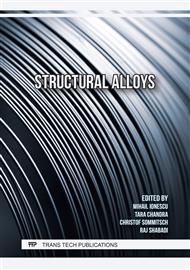[1]
E.O. Hall, The deformation and ageing of mild steel: III Discussion of results, Proc. Phys. Soc. B 64 (1951) 747-753.
DOI: 10.1088/0370-1301/64/9/303
Google Scholar
[2]
N.J. Petch, The cleavage strength of polycrystals, J. Iron Steel Inst. 174 (1953) 25-28.
Google Scholar
[3]
T.G. Langdon, A unified approach to grain boundary sliding in creep and superplasticity, Acta Metall. Mater. 42 (1994) 2437-2443.
DOI: 10.1016/0956-7151(94)90322-0
Google Scholar
[4]
R.B. Figueiredo, T.G. Langdon, Deformation mechanisms in ultrafine-grained metals with an emphasis on the Hall-Petch relationship and strain rate sensitivity, J. Mater. Res. Tech. 14 (2021) 137-159.
DOI: 10.1016/j.jmrt.2021.06.016
Google Scholar
[5]
T.G. Langdon, Seventy-five years of superplasticity: historic developments and new opportunities, J. Mater. Sci. 44 (2009) 5998-6010.
DOI: 10.1007/s10853-009-3780-5
Google Scholar
[6]
T.G. Langdon, The mechanical properties of superplastic materials, Metall. Trans. A 13A (1982) 689-701.
Google Scholar
[7]
R.Z. Valiev, Y. Estrin, Z. Horita, T.G. Langdon, M.J. Zehetbauer, Y.T. Zhu, Producing bulk ultrafine-grained materials by severe plastic deformation, JOM 58(4) (2006) 33-39.
DOI: 10.1007/s11837-006-0213-7
Google Scholar
[8]
R.Z. Valiev, O.A. Kaibyshev, R.I. Kuznetsov, R.Sh. Musalimov, N.K. Tsenev, Low-temperature superplasticity of metallic materials, Dokl. Akad. Nauk SSSR 301 (1988) 864-866.
Google Scholar
[9]
J. Wongsa-Ngam, T.G. Langdon, Advances in superplasticity from a laboratory curiosity to the development of a superplastic forming industry, Metals 12 (2022) 1921.
DOI: 10.3390/met12111921
Google Scholar
[10]
T.G. Langdon, Overview: Using severe plastic deformation in the processing of superplastic materials, Mater. Trans. (2023) in press (doi.org/.
Google Scholar
[11]
R.Z. Valiev, T.G. Langdon, Principles of equal-channel angular pressing as a processing tool for grain refinement, Prog. Mater. Sci. 51 (2006) 881-981.
DOI: 10.1016/j.pmatsci.2006.02.003
Google Scholar
[12]
A.P. Zhilyaev, T.G. Langdon, Using high-pressure torsion for metal processing: Fundamentals and applications, Prog. Mater. Sci. 53 (2008) 893-979.
DOI: 10.1016/j.pmatsci.2008.03.002
Google Scholar
[13]
M. Kawasaki, Z. Horita, T.G. Langdon, Microstructural evolution in high purity aluminum processed by ECAP, Mater. Sci. Eng. A 524 (2009) 143-150.
DOI: 10.1016/j.msea.2009.06.032
Google Scholar
[14]
C. Xu, Z. Horita, T.G. Langdon, Microstructural evolution in an aluminum solid solution alloy processed by ECAP, Mater. Sci. Eng. A 528 (2011) 6059-6065.
DOI: 10.1016/j.msea.2011.04.017
Google Scholar
[15]
A.P. Zhilyaev, G.V. Nurislamova, B.K. Kim, M.D. Baró, J.A. Szpunar, T.G. Langdon, Experimental parameters influencing grain refinement and microstructural evolution during high-pressure torsion, Acta Mater. 51 (2003) 753–765.
DOI: 10.1016/s1359-6454(02)00466-4
Google Scholar
[16]
J. Wongsa-Ngam, M. Kawasaki, T.G. Langdon, A comparison of microstructures and mechanical properties in a Cu-Zr alloy processed using different SPD techniques, J. Mater. Sci. 48 (2013) 4653-4660.
DOI: 10.1007/s10853-012-7072-0
Google Scholar
[17]
H. Ishikawa, F.A. Mohamed, T.G. Langdon, The influence of strain rate on ductility in the superplastic Zn-22% Al eutectoid, Phil. Mag. 32 (1975) 1269-1271.
DOI: 10.1080/14786437508228105
Google Scholar
[18]
F.A. Mohamed, T.G. Langdon, Deformation mechanism maps for superplastic materials, Scripta Metall. 10 (1976) 759-762.
DOI: 10.1016/0036-9748(76)90358-6
Google Scholar
[19]
F.R.N. Nabarro, Deformation of crystals by the motion of single ions, in: Report of a Conference on Strength of Solids, The Physical Society, London, U.K. (1984), pp.75-90.
Google Scholar
[20]
C. Herring, Diffusional viscosity of a polycrystalline solid, J. Appl. Phys. 21 (1950) 437-445.
Google Scholar
[21]
R.L. Coble, A model for boundary diffusion controlled creep in polycrystalline materials, J. Appl. Phys. 34 (1963) 1679-1682.
DOI: 10.1063/1.1702656
Google Scholar
[22]
J.E. Bird, A.K. Mukherjee, J.E. Dorn, Correlations between high-temperature creep behavior and structure, in: (D.G. Brandon and A. Rosen, Eds.), Quantitative Relation Between Properties and Microstructure Israel Universities Press, Jerusalem, Israel (1959) pp.255-342.
Google Scholar
[23]
M. Kawasaki, T.G. Langdon, The many facets of deformation mechanism mapping and the application to nanostructured materials, J. Mater. Res. 28 (2013) 1827-1834.
DOI: 10.1557/jmr.2013.55
Google Scholar
[24]
M. Kawasaki, H.J. Lee, T.G. Langdon, Microstructural homogeneity and superplastic behavior in an aluminum-copper eutectic alloy processed by high-pressure torsion, J. Mater. Sci. 50 (2015) 6700-6712.
DOI: 10.1007/s10853-015-9224-5
Google Scholar
[25]
L.K.L. Falk, P.R. Howell, G.L. Dunlop, T.G. Langdon, The role of matrix dislocations in the superplastic deformation of a copper alloy, Acta Metall. 34 (1986) 1203-1214.
DOI: 10.1016/0001-6160(86)90007-6
Google Scholar
[26]
R.Z. Valiev, T.G. Langdon, An investigation of the role of intragranular dislocation strain in the superplastic Pb-62% Sn eutectic alloy, Acta Metall. Mater. 41 (1993) 949-954.
DOI: 10.1016/0956-7151(93)90029-r
Google Scholar
[27]
T.G. Langdon, An evaluation of the strain contributed by grain boundary sliding in superplasticity, Mater. Sci. Eng. A 174 (1994) 225-230.
DOI: 10.1016/0921-5093(94)91092-8
Google Scholar
[28]
R.B. Figueiredo, M. Kawasaki, T.G. Langdon, Seventy years of Hall-Petch, ninety years of superplasticity and a generalized approach to the effect of grain size on flow stress, Prog. Mater. Sci. 137 (2023) 101131.
DOI: 10.1016/j.pmatsci.2023.101131
Google Scholar
[29]
Z.C. Cordero, B.E. Knight, C.A. Schuh, Six decades of the Hall=Petch effect – a survey of grain-size strengthening studies on pure metals, Int. Mater. Res. 61 (2016) 495-512.
DOI: 10.1080/09506608.2016.1191808
Google Scholar
[30]
S.N. Naik, S.M. Whalley, The Hall-Petch and inverse Hall-Petch relations and the hardness of nanocrystalline metals, J. Mater. Sci. 55 (2020) 2661-2681.
DOI: 10.1007/s10853-019-04160-w
Google Scholar
[31]
N.Q. Chinh, D. Olasz, A.Q. Ahmed, G. Sáfrán, J. Lendvai, T.G. Langdon, Modification of the Hall-Petch relationship for submicron-sized fcc metals, Mater. Sci. Eng. A 862 (2023) 144419.
DOI: 10.1016/j.msea.2022.144419
Google Scholar



